Characteristics
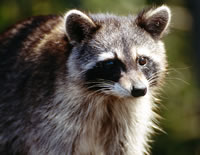 The raccoon has gray to brown fur. It has a black mask around its eyes with white fur around the mask. It has a stripe that runs from its forehead to its nose and white fur around its nose. It has a bushy, ringed tail and black paws with five toes. The raccoon's paws look a little like human hands. The raccoon's toes are flexible and it is very good at grabbing, pulling things apart and holding things. The raccoon is a very good climber and can go down a tree backwards or face first! The raccoon has gray to brown fur. It has a black mask around its eyes with white fur around the mask. It has a stripe that runs from its forehead to its nose and white fur around its nose. It has a bushy, ringed tail and black paws with five toes. The raccoon's paws look a little like human hands. The raccoon's toes are flexible and it is very good at grabbing, pulling things apart and holding things. The raccoon is a very good climber and can go down a tree backwards or face first!
Range
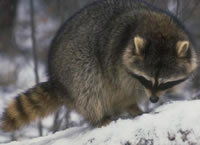 The raccoon can be found in most of the United States except for parts of the Rocky Mountains, central Nevada, Utah and Arizona. It is also found in southern Canada and from Mexico to northern South America. The raccoon can be found in most of the United States except for parts of the Rocky Mountains, central Nevada, Utah and Arizona. It is also found in southern Canada and from Mexico to northern South America.
Habitat
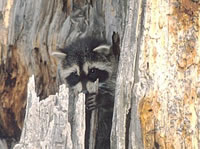 The raccoon lives in wooded areas near water. It is very adaptable though and is also found in suburbs and cities. It usually makes its den in a tree, but it may make its home in an abandoned woodchuck burrow, a cave, barn, sewer, or even a house! The raccoon lives in wooded areas near water. It is very adaptable though and is also found in suburbs and cities. It usually makes its den in a tree, but it may make its home in an abandoned woodchuck burrow, a cave, barn, sewer, or even a house!
Diet
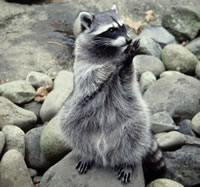 The raccoon is omnivorous and opportunistic. Common foods include fruits, nuts berries, insects, rodents, frogs, eggs and crayfish. In some rural areas, corn is a large part of the raccoon's diet. In suburban and urban areas it often forages through trash cans for food. If water is near, the raccoon will sometimes put its food in the water and roll it around. It looks like it is washing its food, but it is not. The raccoon is softening the food and looking for foreign objects on the food. The raccoon is omnivorous and opportunistic. Common foods include fruits, nuts berries, insects, rodents, frogs, eggs and crayfish. In some rural areas, corn is a large part of the raccoon's diet. In suburban and urban areas it often forages through trash cans for food. If water is near, the raccoon will sometimes put its food in the water and roll it around. It looks like it is washing its food, but it is not. The raccoon is softening the food and looking for foreign objects on the food. |
|
|
Life Cycle
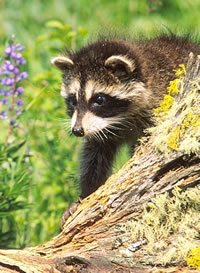 Mating season runs January through March. A little over two months after mating, the female gives birth to a litter of between four to six young. The babies are able to stand when they are about four to six weeks old. They are weaned at 70 days and start to hunt when they are between 9-12 weeks old. When they first come out of the den, the mother may carry them around by the neck, like a cat carries a kitten. The mother also teaches them how to hunt for food and climb trees. The mother raccoon is very protective of her young and will attack predators that come too close. Young raccoons have darker coats than mature raccoons. The babies may stay with their mother for up to a year. Mating season runs January through March. A little over two months after mating, the female gives birth to a litter of between four to six young. The babies are able to stand when they are about four to six weeks old. They are weaned at 70 days and start to hunt when they are between 9-12 weeks old. When they first come out of the den, the mother may carry them around by the neck, like a cat carries a kitten. The mother also teaches them how to hunt for food and climb trees. The mother raccoon is very protective of her young and will attack predators that come too close. Young raccoons have darker coats than mature raccoons. The babies may stay with their mother for up to a year.
Behavior
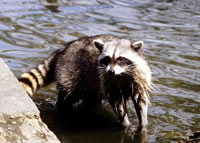 The raccoon is mostly nocturnal. It is also solitary, except for mothers and their young. In the winter the raccoon may sleep in its den for a few weeks but it does not hibernate. The raccoons usually walks, but it can run at speeds of up to 15 miles an hour. It is also a good swimmer and often hunts for food in the water. The raccoon makes a variety of vocalizations including hisses, whistles, screams, growls and snarls.
Image Credits: Clipart.com
|